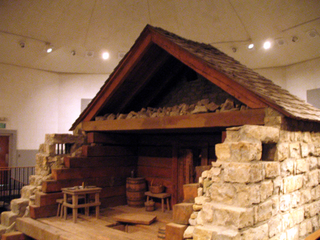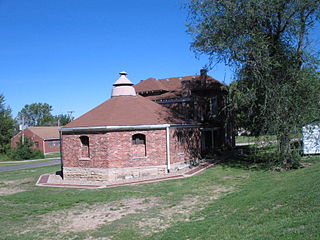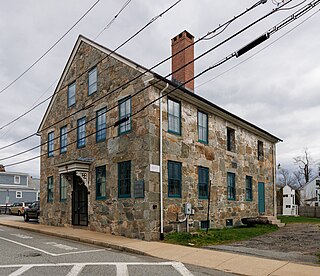
Jackson County is located in the western portion of the U.S. state of Missouri, on the border with Kansas. As of the 2020 census, the population was 717,204. making it the second-most populous county in the state.

Greenwood is a city in and one of the two county seats of Sebastian County, Arkansas, United States. It is the fifth largest municipality in the Fort Smith, Arkansas-Oklahoma Metropolitan Statistical Area with a population of 8,952 according to the 2010 US Census. According to estimates based on the most recent census, the population of Greenwood in 2018 was 9,397.

Independence is the 5th most populous city in Missouri, United States, and the county seat of Jackson County. Independence is a satellite city of Kansas City, Missouri, and is the largest suburb on the Missouri side of the Kansas City metropolitan area. In 2020, it had a total population of 123,011.

Kilmainham Gaol is a former prison in Kilmainham, Dublin, Ireland. It is now a museum run by the Office of Public Works, an agency of the Government of Ireland. Many Irish revolutionaries, including the leaders of the 1916 Easter Rising, were imprisoned and executed in the prison by the orders of the UK Government.

Liberty Jail is a historical jail in Liberty, Missouri, United States, which served as the county jail of Clay County, Missouri between December 1834 and 1853. The jail is known in The Church of Jesus Christ of Latter-day Saints due to the imprisonment of Church president Joseph Smith and some of his associates during the 1838 Mormon War.

The First Battle of Independence was a minor engagement of the American Civil War, occurring on August 11, 1862, in the city of Independence, located in Jackson County, Missouri. Its result was a Confederate victory, continuing the Southern domination of the Jackson County area for a few days while the recruiters completed their work.

Phelps County Jail is a historic jail located on Park Street between Second and Third Streets, Rolla, Missouri, was built in 1860 for $3,000. The jail was operated by Phelps County from 1860 to 1912. Union forces, which took over the town in 1861, used the jail for both military and civilian prisoners during the American Civil War. The building's contractor, John A. Schnable, built the structure from solid dolomite blocks, measuring 22 by 22 inches, which were quarried nearby. The lower floor contains two windowless 6-by-13-foot stone cells for solitary confinement. The upper floor contains a single room with cages made from iron bars to hold multiple prisoners. The upper floor also includes a wood-burning stove used for heating. Dr. E.A. Stricker presented the jail to the Phelps County Historical Society in 1943.

A rotary jail was an architectural design for some prisons in the Midwestern United States during the late 19th century. Cells in the jails were wedges on a platform that rotated in a carousel fashion. The surrounding of the entire level had a single opening, allowing only one cell at a time to be accessible.

In the United States, a sheriff is the chief of law enforcement of a county. Sheriffs are usually either elected by the populace or appointed by an elected body.

Bristol County Jail is a historic jail at 48 Court Street in Bristol, Rhode Island, and home to the Bristol Historical and Preservation Society.

The New County Jail is a structure within the Appomattox Court House National Historical Park. It was registered in the National Park Service's database of Official Structures on June 26, 1989.

The Old Allen County Jail is a former jail in Iola, Kansas, United States. Built in the late 1860s, it operated as a detention facility for nearly a century before a replacement opened; today, it is the Old Jail Museum, operated by the Allen County Historical Society, and it has been designated a historic site.

The Pottawattamie County Jail, also known as 'Squirrel Cage Jail' in Council Bluffs, Iowa, United States was built in 1885 and it was listed on the National Register of Historic Places in 1972. The building is one of three extant “squirrel cage jails,” also known as rotary jails. It was designated a National Historic Landmark in 2023.

Kewaunee County Sheriff's Residence and Jail is a building in Kewaunee, Wisconsin, located at 613 Dodge Street on the southeast corner of the courthouse square. It was built in 1876 as the sheriff's office, residence, and county jail. The building was added to the National Register of Historic Places in 1996.

The Old Jail, also known as the Old Wilkes County Jail, located at 15 Court Street in Washington, Georgia was built in 1891. It was built by the McDonald Brothers Company of Louisville. The Old Jail has been on the list of National Register of Historic Places since June 5, 1974. It is a contributing member to the Washington Commercial Historic District, which was included on the National Register of Historic places on March 6, 1986.

The former Hancock County Jail is located at 40 State Street in Ellsworth, the county seat of Hancock County, Maine. Built in 1885–86, it has a well-appointed living space for the jailer in the front, and a series of cells in the back. It was operated as a jail until the early 1970s, and is now home to the Ellsworth Historical Society, which operates it as a museum. It was listed on the National Register of Historic Places in 2008 for its architectural and historical significance.

The former Adams County Jail, also known as the House of History: Adams County Historical Society, is located in Corning, Iowa, United States. The limestone structure was built in 1877, and it mimicked the adjacent frame courthouse. The two-story rectangular building is a Vernacular style structure with Greek Revival influence. It is capped with a hipped roof and a flat crest. It served the county for the next 78 years as its jailhouse. The building also provided residential space on the lower level to the sheriff, or if he had his own house, to the jailer. The upper floor held the cells. The most notable event at the jail was the lynching of local farmer John W. McKenzie in 1887, who had shot his neighbor. The building was converted into apartments in 1955, and a museum in 1969. It listed on the National Register of Historic Places in 1991.

In the United States, a one-room jail is a type of jail with only one room, or cell.

Rockdale County Jail is a historic building at 967 Milstead Ave. in Conyers, Georgia. It was built in 1897 and served as the jail for Rockdale County, Georgia from then until a new jail was built in 1968. It was entered into the National Register of Historic Places (NRHP) on August 26, 1982. It now serves as the headquarters for the Rockdale County Historical Society and is known as the Old Jail Museum.

Bowie County Jail is a historic prison located in Boston, Texas.





















